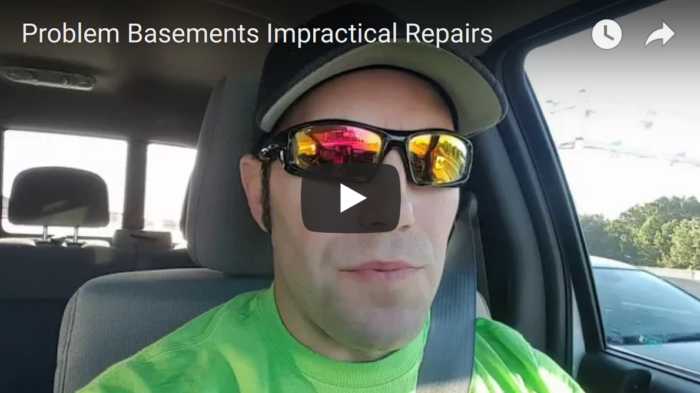When Problem Basements Can’t Be Repaired
In the Kansas City metro, we are have heard or dealt with problem basements. We all desire to repair and maintain our properties to it’s best. However, there are times when the repairs needed to correct the foundation leaks or the drainage problems is far more costly than what the property is worth or what the homeowner might be able to afford.
What are some practical ways to maintain a dry and mold-free environment when you are working with these conditions? In this video, our top mold expert, Ben Fetzer, will walk you through very practical and cost-effective steps to maintaining a dry basement that is free of mold and can be maintained to sanitary conditions without much effort. We know the challenges and frustrations with dealing with problem basements. You are encouraged to take every possible step to repair or renovate your basement (visit this website to find appropriate experts for the job) for long-term solutions and to create a healthier space. However, if you find yourself in a situation where you are unable to repair problem basements, feel free to call and speak with one of our mold experts if you need any help!
5 Steps to a Healthy Basement
Good morning! I am going to do a quick video here for anybody out there with problem basements and wondering how foundation repair works. The type of basement that floods and it’s really hard to figure out why it will…how to get it to stop flooding. Maybe it’s a significant drainage issue or a foundation repair that needs to be done. And it’s very expensive and not practical to have that done. So, if that’s you and you got a basement like that, you might want to immediately contact professionals near you who can help get it repaired immediately. If you are unsure of whom to contact, do a quick google search using keywords with your place name and requirement, for example, “Milwaukee Basement Repair“. From the results that appear, contact the one who is feasible to your conditions. That said, I want to point out that I’ve even seen very nice houses that are 100 years old and they’ve all been renovated. But the original foundation is stone. So they still have a little bit of seepage as far as water. Anyway. That’s even a situation where it’s not so much the basements failing or the foundations failing. It’s just never been watertight from day one. So those basements have to just be maintained.
1. Go Back to the Foundation Wall
And here’s a few things you need to do. Number one unfinish that basement. Take down the drywall, take down the framing. Get rid of anything organic. As far as building materials. So that when the water does come in. You’re not dealing with a lot of wood or drywall that easily grows mold when it gets wet.
2. Remove Water & Dehumidify
Number two. Get yourself a shop vac or a squeegee or both. And when the water comes. Go ahead squeegee it down the drain if you have the proper slope on your floor. If not get your shop vac going and just shop back up the water get the water off the surface. Number three get yourself a dehumidifier or maybe two. 70 pint is the size that I recommend. And get one with a pump-out system that will pump the water out of the tank. So you don’t have to worry about the hose being gravity fed and being lower than the tank and all that drama. And you don’t want to have to think about emptying the bucket. So it’s really simple to get one with a pump-out system. 70 pint and you can buy them at the big box stores.
3. Monitor Indoor Humidity
Also, buy a little humidity gauge. That’s $10 or so and tells you relative humidity and temperature. And keep your humidity below 60 I would shoot for more like 55 percent relative humidity. The next thing to do is build some shelving either metal or if you’re going to use wood. Block the wooden legs up off the ground with some cinderblocks or some type of a concrete block so that if you do have some water it’s not getting that wooden leg wet and creating a problem with potential mold. Another thing you’ve got to be careful of is radon, because it can get into the basement without your knowledge. It’s quite a dangerous gas, and can cause health problems with too much exposure. Radon can be found in basements of homes or offices, get your building tested today!
4. Water Tight Storage Only
The other thing is all of your content you’re going to be stored in the basement. Do not put it in cardboard boxes. Put it in plastic containers that seal tight. So your contents stay clean. And they are dry if you did have some water and it came in contact with you, with your tote. You’re not going to be ruining it or getting mold if it’s in a box so. That you got a nice plastic tote you to stick it on the shelf. Nothing gets wet.
5. Act Quickly
Your basement may get wet for a short amount of time but if you have to dehumidifiers and get the water off the floor. In 12 hours you didn’t even know it happened. So its a way easier situation than if you had carpet, drywall, doors, and all kinds of stuff down there getting moldy or just damaged from the water. It’s just a much better scenario if you have a basement that you can’t really control. As far as humidity and water that you want to just maintain it. With the steps that I just mentioned. So. If there are any other questions. Look us up at moldkansascity.com. This is Ben Fetzer with FreshStart Restoration Have a great day.
